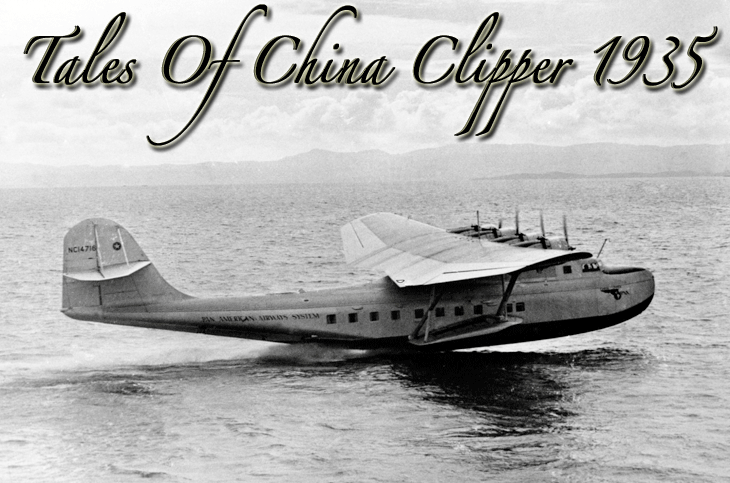
China Clipper flies off into history establishing the first scheduled
transpacific air service from USA via Hawaii in 1935.
Aviation lovers—and
we suspect that includes quite a few folks who read FlyingTypers—are
invited to take a ride back in time to 80 years ago. In 1935 the China
Clipper (NC14716), one of three Martin M-130 four-engine flying boats
built for Pan American Airways in Middle River, Maryland, inaugurated
the first commercial transpacific air service from San Francisco to Manila,
connecting the U.S. to Asia.
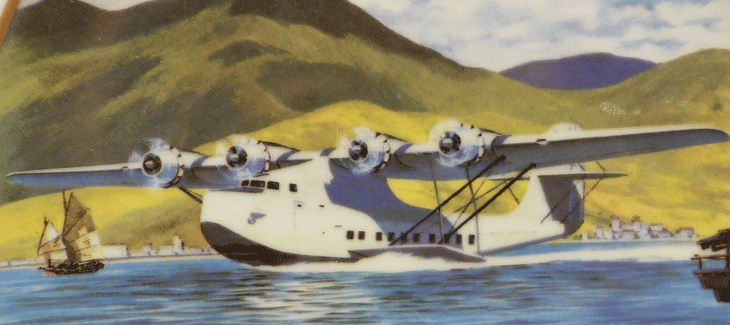
Elegant detail of China Clipper captured on a plate.
But the real revenue that paid for that
historic first flight was mail and express cargo.
The “China Clipper” departed Alameda
as (FAM 14) on November 22, 1935.
On November 29, China Clipper reached its destination,
Manila, after traveling via Honolulu, Midway Island, Wake Island, and
Guam, and delivered over 110,000 pieces of mail.
The crew for this flight included Edwin C. Musick
as Chief Pilot.
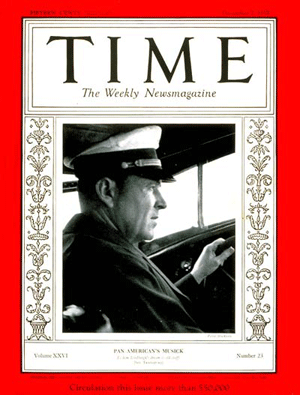 A
picture of Capt. Musick in 1935. After the flight of the China Clipper,
Capt. Musick was a national hero, featured on the cover of Time Magazine. A
picture of Capt. Musick in 1935. After the flight of the China Clipper,
Capt. Musick was a national hero, featured on the cover of Time Magazine.
Musick had pioneered routes everywhere, including
Latin America, when he served as chief pilot for Ralph O/Neill’s
New York, Rio, & Buenos Aires Line, which established routes from
New York City to South America in 1928 and later was acquired by Pan Am.
The navigator aboard China Clipper was Fred Noonan.
Noonan would disappear a scant two years later,
serving a similar function with Amelia Earhart’s doomed attempt
to circumnavigate the world aboard a tiny Lockheed 10 that was lost forever
in the South Pacific.
But 80 years ago, the inauguration of ocean airmail
service and commercial air flight across the Pacific was a global event
for aviation, thrilling millions of people all over the world as constant
coverage updated every move from lift off, to island hopping across the
vast Pacific Ocean, to the mania aroused after safely landing in Manila
Harbor.
In The News
The San Francisco Chronicle reported:
“The voyage across the link in the California-Manila
route was accomplished in much faster time than Capt. E.C. Musick, skipper
of the 25-ton craft, had anticipated.”
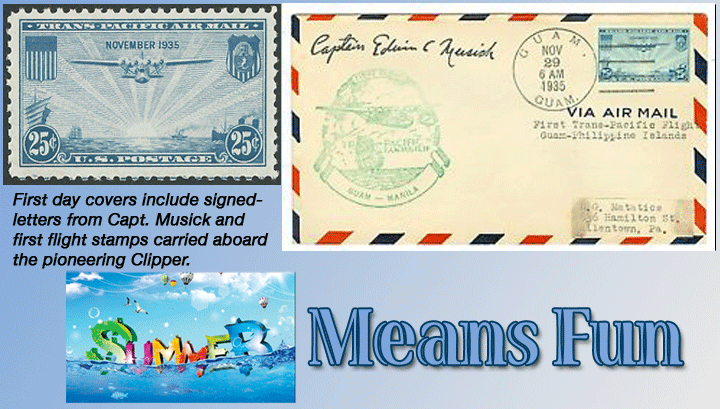
Dips Over
Lincoln
“In about 38 and one-half hours of flying,
the China Clipper has crossed nearly 5,200 miles of the 8,000-mile distance
between Alameda, Calif., and Manila, end of the present journey to establish
transpacific air mail service,” The SFO Examiner said.
“Mail and supplies for the Wake Airways
Station arrived aboard the seaplane which also brought nine employees,
who will be stationed here.
“En route, the plane dipped low over the
steamship President Lincoln, which saluted with three whistle blasts.
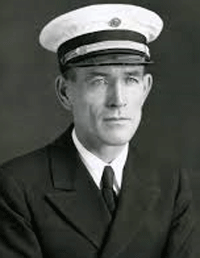 In
2015 Fred Noonan, a little known China Clippers navigator, is better recognized
than Musick today. Noonan took off with Amelia Earhart in 1937 in an attempt
to circumnavigate the world. The duo disappeared forever. In
2015 Fred Noonan, a little known China Clippers navigator, is better recognized
than Musick today. Noonan took off with Amelia Earhart in 1937 in an attempt
to circumnavigate the world. The duo disappeared forever.
“The China Clipper left
Alameda Friday afternoon [Nov. 22, 1935], and stopped overnight at Honolulu
and Midway and finally at Wake Island and Guam.”
Here the takeoff from Midway Island is described.
“At 10:30 a.m. (our time), four hours and
a quarter after our takeoff from Midway, we passed the halfway mark on
this long voyage to Manila.
“Picking up our first tail wind of the
day only a short time before, we are clicking along at 160 miles per hour.
“We got up with the gooney birds this morning
at a quarter to four, Midway time, and had our breakfast all tucked away
before daylight.
“The lagoon was calm in the tropic dawn
as Captain Musick gave our 3,200 horses their heads, and the goonies flapped
up with shrill screams at their roar,” SFO Chonicle reported.
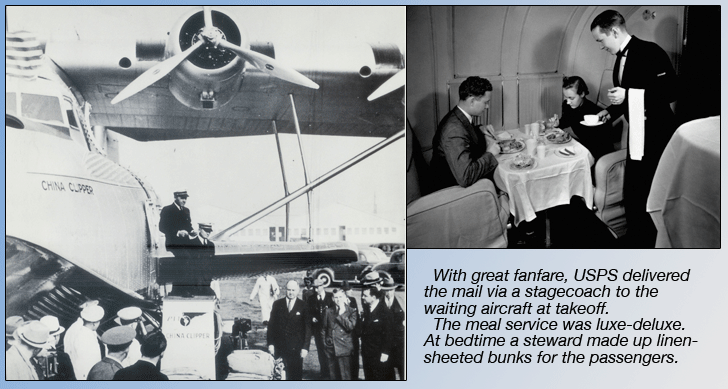
Dateline Crossed
Today, millions regularly cross the international
dateline, and think nothing of it.
Perhaps you have to use your imagination to envision
the excited clamor of those who witnessed a journey “crossing the
line” in 1935.
“On today’s flight, the international
dateline was crossed, and time aboard the four-motored craft jumped ahead
one whole day.
“Ahead of the plane lies a 1,500-mile flight
to Guam, last of the island way stations, and then a flight of 1,700 miles
into Manila.”
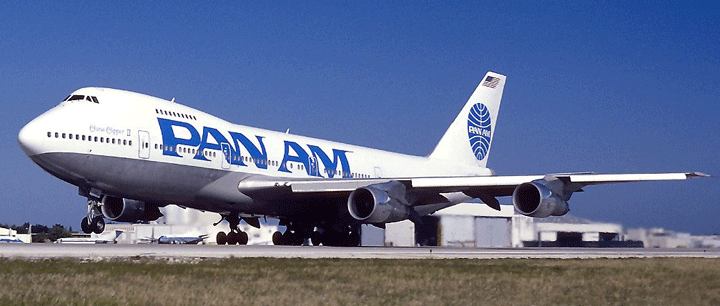
China Clipper II in 1985.
Remembering
The China Clipper
Pan American World Airways managed to stay in
business until 1991. Along the way it launched the China Clipper II, fifty
years after the epic first flight of that tiny flying boat, which by 1985
was recalled as a journey into a “once upon a time world.”
(Postscript) I can recall, as a U.S. soldier flying off to Vietnam
aboard a World Airways DC7 military charter in the late 1960s, that we
stopped at Wake Island to refuel.
Of course, as soldiers destined for a war zone,
we all disembarked to get to the bar and drink as much as possible before
takeoff to Saigon.
But I was immediately caught up observing the
remnants of the old Pan Am base, and further by the stunning beauty of
the island and the deep indigo of the Pacific Ocean enveloping the tiny
strip of land.
I recall experiencing a tropical contact-high
after looking around Wake Island that caused me to miss the libations
of that tiki bar prior to flight departure.
Today I can only imagine that China Clipper flight,
with an overnight stay in a small hotel and onward journey at 160mph,
as described here.
Happy Birthday, China Clipper, and thanks.
Geoffrey

|





